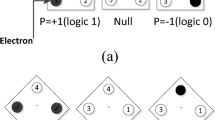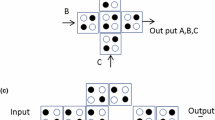Abstract
Nowadays, quantum-dot cellular automata (QCA) is one of the paramount modern technologies for designing logical structures at the nano-scale. This technology is being used in molecular levels and it is based on QCA cells. High speed data transfer and low consumable power are the advantages of this technology. In this paper, we are designing and simulating a fulladder/subtractor with minimum number of cells and complexities in three layers. QCA designer software has been used to simulate the proposed design.












Similar content being viewed by others
References
Lent, C.S., Tougaw, P.D., Porod, W., Bernstein, G.H.: Quantum cellular automata. Nanotechnology 4, 49–57 (1993)
Lent, C.S., Tougaw, P.D.: Adevice architecture for computing with quantum dots. Proc. IEEE 85, 541–557 (1997)
Sayedsalehi, S., Azghadi, M.R., Angizi, S., Navi, K.: Restoring and non-restoring array divider designs in quantum-dot cellular automata. Inf. Sci. 311, 86–101 (2015)
Wang, W, Walus, K, Jullien, GA: Quantum-dot cellular automata adders. In: Nanotechnology, 2003. IEEE-NANO 2003, Third IEEE Conference, pp. 461–464. IEEE (2003)
Abedi, D., Jaberipur, G., Sangsefidi, M.: Coplanar full adder in quantum-dot cellular automata via clock-zone based crossover. IEEE Trans. Nanotechnol. 14(3), 497–504 (2015)
Hanninen, I., Takala, J.: Robust adders based on quantum-dot cellular automata. In: Application-Specific Systems Architectures and Processors, 2007. ASAP. IEEE International Conference 2007, pp. 391–396. IEEE
Tougaw, P.D., Lent, C.S.: Logical devices implemented using quantum cellular automata. J. Appl. Phys. 75 (1994)
Angizi, S., Alkaldy, E., Bagherzadeh, N., Navi, K.: Novel robust single layer wire crossing approach for exclusive or sum of products logic design with quantum-dot cellular automata. J. Low Power Electron. 10, 259–271 (2014)
Heikalabad, S.R., Navin, A.H., Hosseinzadeh, M.: Midpoint memory: a special memory structure for data-oriented models implementation. J. Circ. Syst. Comput. 24(5) (2015)
Heikalabad, S.R., Navin, A.H., Hosseinzadeh, M.: Content addressable memory cell in quantum-dot cellular automata. Microelectron. Eng. 163, 140–150 (2016)
Karkaj, ET, Heikalabad, S.R.: Binary to gray and gray to binary converter in quantum-dot cellular automata. Optik - Int. J. Light Electron. Opt. 130. doi:10.1016/j.ijleo.2016.11.087 (2017)
Karkaj, E.T., Heikalabad, S.R.: A testable parity conservative gate in quantum-dot cellular automata. Superlattice. Microst. doi:10.1016/j.spmi.2016.08.054 (2016)
Asfestani, M.N., Heikalabad, S.R.: A unique structure for the multiplexer in quantum-dot cellular automata to create a revolution in design of nanostructures. Physica B: Phys. Condens. Matter. doi:10.1016/j.physb.2017.02.028
Landauer, R.: Irreversibility and heat generation in the computational process? IBM J. Res. Dev. 5, 183–191 (1961)
Sheikhfaal, S., Angizi, S., Sarmadi, S., Moaiyeri, M.H., Sayedsalehi, S.: Designing efficient QCA logical circuits with power dissipation analysis. Microelectron. J. 46, 462–471 (2015)
Zhang, R., Walnut, K., Wang, W., Jullien, G.: A method of majority logic reduction for quantum cellular automata. IEEE Trans. Nanotechnol. 3, 443–450 (2004)
Moein, K., Reza, S.N., Keivan, N.: A novel design of 8-bit adder/subtractor by quantum-dot cellular automata. J. Comput. Syst. Sci. 80, 1404–1414 (2014)
Cho, H., Swartzlander, E.E.: Adder and multiplier design in quantum-dot cellular automata. IEEE Trans. Comput. 58, 721–727 (2009)
Hänninen, I., Takala, J.: Binary Adders on Quantum-Dot Cellular Automata, pp 87–103. Springer Science, Business Media, LLC, USA (2008)
Azghadi, M.R., Kavehei, O., Navi, K.: A novel design for quantum-dot cellular automata cells and full-adders. J. Appl. Sci. 7, 3460–3468 (2007)
Author information
Authors and Affiliations
Corresponding author
Rights and permissions
About this article
Cite this article
Barughi, Y.Z., Heikalabad, S.R. A Three-Layer Full Adder/Subtractor Structure in Quantum-Dot Cellular Automata. Int J Theor Phys 56, 2848–2858 (2017). https://doi.org/10.1007/s10773-017-3453-0
Received:
Accepted:
Published:
Issue Date:
DOI: https://doi.org/10.1007/s10773-017-3453-0




